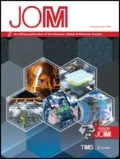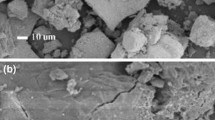Abstract
Hydrated ferrous sulfate, a by-product of the titanium-dioxide and steel-surface-treatment industries, is usually disposed of as waste at a significant extra cost for these industries. Due to tight environmental regulations in the European countries, waste disposal of ferrous sulfate will not be an acceptable solution in the near future. Consequently, the waste will have to be treated. Recently, ferrous sulfate was successfully used to synthesize a novel superoxidant material (potassium ferrate) containing iron in hexavalent state (FeVI). With ferrates synthesis, innovative applications are possible in different industrial sectors, such as treatment of water and wastewater and effluent decontamination.
Similar content being viewed by others
References
N. Schmitt-Neveux, “Voie de Synthèse Originale de Ferrates (VI) Alcalins Stabilisés et Leurs Applications Potentielles dans le Traitement des Eaux” (Ph.D. Thesis, Université de Nancy I, Nancy, France, April 1993).
P.W. Harben, The Industrial Minerals Handybook, 2nd edition (London: Industrial Minerals Divisions, Metal Bulletin PLC, 1995), pp. 187–189.
R. Perrin and J.P. Scharff, Chimie Industrielle (Masson, Paris, 1993), Tome 1, pp. 393–399.
J. M. Blondel, SOLVAY SA, Private communication, 24 September 1997.
E.F. Fremy, “Recherchessur l’Action des Peroxydes Alcalins sur les Oxydes Métalliques,” C.R. Acad. Sci., 257 (1841), pp. 23–24.
O. Evrard et al., “Ferrates of Alkali or Alkaline Earth Metals, Their Preparation and Their Industrial Applications” (International Patent WO 91/07352, 1991).
N. Aubertin et al., “Synthèse d’un Sulfatoferrate de Potassium et Son Efficacité dans le Traitement des Eaux,” Rev. Sci. Eau., 9 (1) (1996), pp. 17–30.
P. Pascal, Nouveau Traité de Chimic Minérale (Paris, Tome II(2), 1963), p. 51.
R.H. Wood, “The Heat, Free Energy and Entropy of the Ferrate(VI) Ion,” J. Am. Chem. Soc., 80, (1958), pp. 2038–2039.
L. Delaude and P. Laszo, “A Novel Oxidizing Reagent Based on Potassium Ferrate(VI),” J. Org. Chem., 61 (1996), pp. 6360–6370.
C.M. Vogels and M.D. Johnson, “Arsenic Remediation in Drinking Waters using Ferrate and Ferrous Ions” (Technical Completion Report, Account number 01-4-23922, New Mexico, 1998).
Author information
Authors and Affiliations
Additional information
For more information, contact N. Kanari, Laboratoire Environnement et Minéralurgie (LEM), Mineral Processing and Environmental Engineering team, BP 40, 54501 Vandœuvre, France.
Rights and permissions
About this article
Cite this article
Kanari, N., Evrard, O., Neveux, N. et al. Recycling ferrous sulfate via super-oxidant synthesis. JOM 53, 32–33 (2001). https://doi.org/10.1007/s11837-001-0191-8
Issue Date:
DOI: https://doi.org/10.1007/s11837-001-0191-8




